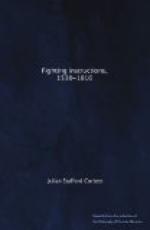[5] The Admiralty MS. makes of the three paragraphs of this instruction three separate instructions, numbered 7, 9, and 10, and inserts after the first paragraph a new instruction numbered 8, with an Observation appended. It is as follows: Additional Instruction, No. VIII.: ’When any of his majesty’s ships that have gained the wind of the enemy, and that the general or admiral would have them bear down and come to a close fight, he will put abroad the same signal as for their tacking, and hoist and lower the same till it be discerned; at which, they that are to windward shall answer by bearing down upon the enemy. Observation.—The same in the battle of Solebay, Sir Joseph Jordan got the wind and kept it for want of a signal or fireships.’ This Observation appears to be intended as a continuation of the previous one, the new instruction supplies the missing signal there referred to.
[6] The Admiralty MS. has this Observation: ’The 28th May, ’73, the battle fought in the Schooneveld, the rear-admiral of their fleet commanded by Bankart (? Adriaen Banckers) upon a signal from De Ruyter gave way for some time, and being immediately followed by Spragge and his division, it proved only a design to draw us to leeward, and that De Ruyter might have the advantage of weathering us. So that for any small number giving way it is not safe for the like number to go after them, but to press the others which still maintain the fight according to the article following.
[7] No.11 in the Admiralty MS. with the following Observation: ’In bearing down upon an enemy when you have the wind, or standing towards them and they towards you, if it is in your power to fall upon any part of their ships, those to windward will be the most exposed; therefore you must use your utmost endeavour to ruin that part. The battle fought in 1666, the headmost or winderly ships were beaten in three hours and put to run before half the rest of the fleet were engaged. We suffered the like on the 4th of June, for Tromp and De Ruyter never bore down to engage the body of our fleet, but pressed the leading ships where Spragge and his squadron had like to have been ruined.’
[8] Admiralty MS. No. 12.
[9] For ‘headmost of the enemy’s ships’ the Admiralty MS. has ’windmost ships of the enemy’s fleet, and endeavour all that can be to force them to leeward.’ Also this Observation: ’It may happen that the headmost of their fleet may be the most leewardly, then in such case you are to follow this instruction, whereas before it was said to stand with the headmost ships of the enemy.’




